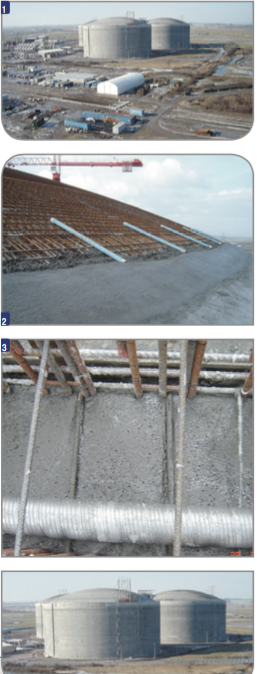 Client
Client
National Grid Transco PLC
Main Contractor
CB&I
Tanks 1,2 & 3 Civils Contractor
Balfour Beatty
Tank 4 Civils Contractor
Taylor Woodrow
Contract Value
£4,000,000
Construction Period
2005 – 2010
Back in 2005, National Grid Transco started the construction to increase the annual importation capacity at Isle of Grain LNG Plant. Constructing four new LNG gas storage tanks with four times the capacity of each of the original LNG storage tanks at Grain – they have quadrupled the LNG handling capacity at the site. The work will take the terminal capacity to 20% of the UK’s current gas demand, making it the foremost LNG importation terminal in the UK.
Freyssinet was awarded the contract for the supply and installation of post-tensioning for LNG tanks 1, 2, 3 & 4.
Each tank is larger than the Royal Albert Hall, and currently the biggest tanks in the world, they have a storage capacity of 190,000mÑ each, a diameter of 92m, height: 40m (top of wall), and have a concrete mass of 72,000 tonnes per tank.
Each tank wall was slip-formed continuously for around 20 days. Anchors and ducting for tendons were installed during this phase by the civils contractor.
The PT construction programme for each tank consisted of three phases. The first phase of post-tensioning works was to install and stress top ring beam tendons to allow the roof dome to be secured and poured. Roof, like walls, was poured continuously 24 hours a day for 6-7 days.
The second phase consisted of the installation, stressing and grouting of the tendons from the ring beam to just above the work access doors. Each tank comprised of 122 horizontal hoop tendons. Each tendon has two live jacking ends and runs around half the circumference of the tank. The tendons were stressed through 4 buttresses located at 90 degrees apart (Buttresses 1, 2, 3 & 4).
The post-tensioning system used was the 28C15 anchorage. Each tendon had 28 strands 15.7mm diameter (max breaking load 279kN per strand). Each tendon was 149m long and stressed to a force of 6250kN. Tendons were protected from corrosion with a high strength grout injected from the live end anchor at one end of the tendon, after stressing.
The third phase occurred after 10 months when the internal structure of the tank was complete; closure of access doors, installation, stressing and grouting tendons across doorways.
1 Overview of Tanks 1, 2 & 3
2 Roof Pour on Tank 4
3 Wall Pour on Tank 4
